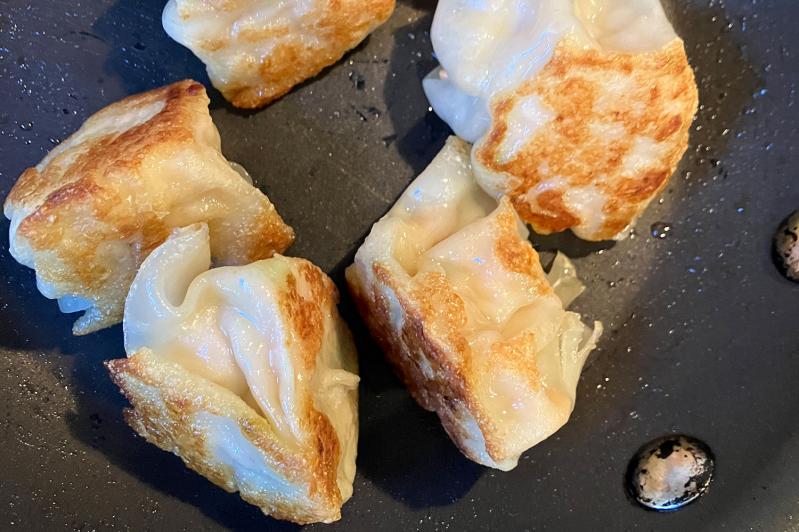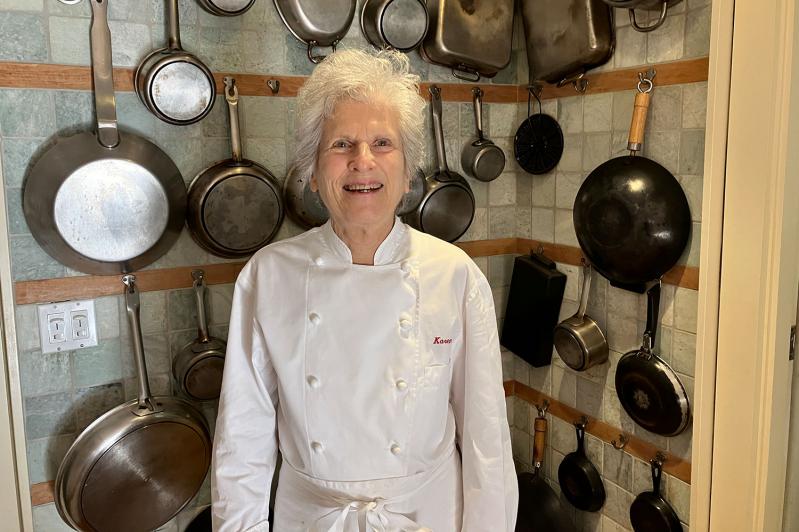The chef Karen Lee, who was making crab cakes with roasted pepper sauce as a surprise for her dog’s vet the other day in Amagansett, is happy to cook for just one person or to cater for as many as 60, though not many more.
“I don’t do big parties. I was doing a wedding once, in New Jersey, for about 135 people, and we had 135 orders of sautéed halibut with spicy tomato cilantro sauce all lined up, perfectly cooked. I was sautéing at the last minute — I do everything á la minute. I shop and I chop and I do some sauces in preparation, but I arrive there and I cook everything fresh — not like some caterers that cook ahead and just reheat it in proofing ovens.”

She made a face. “People ask me what are proofing ovens, I say they’re designed to destroy food. Because you have beautiful food and you put it on trays and you keep it warm, and it goes from great to terrible.”
“Anyway, we were all set. I had 10 waiters and two assistants, super-organized, going so beautifully, and someone came in the kitchen and said, ‘Don’t serve the dinner now, the uncle is giving a speech!’ And he gave a long speech, and I had to put everything in the proofing ovens to reheat. So that was a big disaster from my point of view, because the dish was so fine and so impeccably prepared — but overcooked.”
“Nobody complained, though. I guess at a big function like that, they assume the food’s going to be terrible.”
Once upon a time, maybe 40 years ago when she was a struggling young chef, Ms. Lee got an admiring paragraph in a New York Times roundup of cooking schools, and enough phone calls came in to fill six weeks’ advanced classes. For years now, she hasn’t bothered to advertise. Word of her skills gets around at high-end dinner parties in the Hamptons or the city, where the conversation may be even more about the food than politics or the price of real estate and the guests seek her out in the kitchen later to ask for her card.
She was 22, divorced after a short unhappy marriage and wondering what to do with her life — maybe “something that involved French, or basketball,” said the onetime athlete, who’d been to a French school in Manhattan and university in Quebec — “but I’m very realistic, and I thought, well, that’s not going to bring in any cash.” Undecided and at loose ends, she took a class in Chinese cooking to pass the time, loved it, and never looked back, apprenticing herself to the teacher and washing dishes for five years when she couldn’t afford the fees.
“I became quite good,” she said, smiling, during a recent conversation. “I changed a hobby into a profession.”
One thing led to another. Her students go home from class and recreate what they’ve cooked that day, “and then they invite guests for dinner, and ‘Oh, where did you learn this?’ — and then some of them realize how much work it is and they just call me to cater!” She holds classes at her Upper West Side apartment, or, if she’s here, at her house in Amagansett.
If it’s a new client, she checks out the kitchen in advance or studies emailed photos. “Is there any counter space at all?” There was almost none, she recalled, in one Central Park West apartment where the host often entertained for the American Ballet Theatre. “Baryshnikov would come in the kitchen with a beer in one hand and be eating my spring rolls right out of the wok — and it was, like, very, very cramped.”
Her classes are heavy on fish, “with a lot of healthy, delicious, not-too-complicated dishes” — salmon, sure, but meat and chicken, too. One of her most popular dinner party presentations is a Chinese classic starring ginger beef. Some chefs use flank steak, she said — “Nothing wrong with flank steak, it just has to be marinated a day ahead, with a water chestnut powder and sherry and just a little soy, because it’s a little tough” — but Ms. Lee uses filet mignon instead, letting it shrink overnight in the refrigerator “so it becomes much more luxurious, so you get that big, delicious mouth feel, and I slice it thinly, medium rare on the inside, because it’s so tender. And people go wild.”
She used to drive down Further Lane years ago, she reminisced, “thinking, oh, I wish I could work in one of those homes, but I’m sure they all have chefs” — when the unexpected happened, an opportunity to cook for the Reed Krakoff family, who were living in Jackie Onassis’s old house, Lasata, when he was C.E.O. of Coach.
“So I had to do an audition dinner at their house in New York City. And I thought, ‘I know I could get the job if I could just get those Peconic Bay scallops’ — because the way I prepare them is better than any restaurant I’ve ever eaten at or anyone’s ever eaten at, and I know it sounds conceited to say it, but it’s true. So I got them at Stuart’s, and I made them for a first course for this audition dinner to be a private chef out here — and the family was there with the children, and Mrs. Krakoff said, ‘These are delicious! If you want the job, you’re hired!’ "
She leaned forward, beaming. “I got hired after the first course!” Then she paused. “But I’m only as good as the scallop, you know what I mean? I’m only as good as my ingredients. When you have a really good ingredient, you just try to preserve its integrity.”
She almost always shops locally when preparing a fish dish here, but not always. “Sometimes people will want red snapper, say, or Dover sole, and then I go to Citarella.”
Seriously? Doesn’t she ever demur? Oh, but — you live in a place with the ocean on one side and the bay on the other, full of fresh fish?
“Of course. But you can’t always get your way. It’s whatever they request. I do have one hostess who, when she calls me says, ‘What’s in season? What’s everyone ordering?’ I love those questions.”
When Thanksgiving comes along, Ms. Lee is usually in the city, cooking up a storm. “I cook all week. I call it ‘The Battle of Thanksgiving.’ It’s a difficult dinner, because all the recipes are competing for the oven. It’s very demanding. And when the hostess says ‘Dinner at eight o’clock,’ she doesn’t mean eight-o-one, she means eight. The pressure is enormous. Try to get five things á la minute, all delicious!”
She buys her turkeys at a kosher market on the Upper East Side, “because of the process. It’s similar to brining, produces a crusty exterior for the skin and a very moist interior. I always ask for the smallest turkey possible, three 12-pounders if possible. They’re much more moist. I don’t like big turkeys.”
This coming Thanksgiving, though, has been something of a puzzle. As of a week ago, the woman for whom she’s prepared the feast for the past seven years hadn’t yet called. If she doesn’t, said the chef, “I would happily come out here. I’m still available.”

